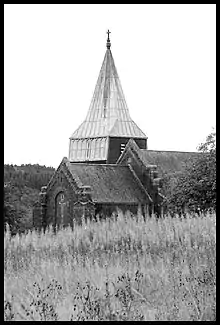Bangour Village Hospital
Bangour Village Hospital was a psychiatric hospital located west of Dechmont in West Lothian, Scotland. During the First World War it formed part of the much larger Edinburgh War Hospital.[1]
| Bangour Village Hospital | |
|---|---|
| NHS Lothian | |
.jpg.webp) Old buildings at Bangour Village Hospital | |
 Shown in West Lothian | |
| Geography | |
| Location | Dechmont, West Lothian, Scotland, United Kingdom |
| Coordinates | 55°55′25″N 3°33′00″W |
| Organisation | |
| Care system | Public NHS |
| Type | Psychiatric |
| History | |
| Opened | 1906 |
| Closed | 2004 |
| Links | |
| Lists | Hospitals in Scotland |
History

The hospital was modelled on the village system of patient care, the best example of which is the Alt-Scherbitz hospital at Schkeuditz in Germany which was developed in the 1870s.[2][3] It was designed by Hippolyte Blanc and officially opened as the Edinburgh District Asylum in October 1906.[4] At the centre of the site was an Edwardian Baroque hall.[4][5] The site also incorporated a power station, workshops, a bakery, stores, a kitchen and a laundry.[4]
The hospital was requisitioned by the War Office during the First World War but reverted to psychiatric work between the wars.[2] A Romanesque style church, designed by Harold Ogle Tarbolton, was built between 1924 and 1930.[6]
During the Second World War the hospital was occupied by the War Office again and the patients were evacuated to Hartwoodhill Hospital[7]: 33
Temporary marquees and prefabricated huts were erected to cope with the demand for wartime bed space: the temporary facility became noted for its burns and plastic surgery unit which was established in 1940.[3] After the war the temporary facility was developed as Bangour General Hospital.[3]
After general medical services transferred to the newly-opened St John's Hospital in nearby Livingston, Bangour General Hospital closed in 1991.[8] The Village Hospital also started to wind down after the opening of St Johns with the last remaining ward closing in 2004.[4]
Railway branch line
When the hospital was built, road access was poor, and considerable volumes of coal and general stores were required for the running of the facility. A private railway line was built, branching from the former Edinburgh and Bathgate Railway line at Uphall, and terminating at Bangour railway station. It was authorised by the Edinburgh and District Lunacy Board Act of 30 July 1900, and it was opened to passengers on 19 June 1905.[9]
During the First World War the road network was improved, and the railway became unnecessary; it was closed on 1 August 1921, although passenger services probably ceased on 4 May 1921.[10][11]
Present use
The closed hospital was used as a filming location for the 2005 film The Jacket, starring Keira Knightley and Adrien Brody.[12]
During September 2009, the hospital grounds were used as the site for "Exercise Green Gate", a counter-terrorist exercise run by the Scottish Government to test de-contamination procedures in the event of a nuclear, chemical or biological incident. This involved 250 volunteer "casualties" and 400 emergency staff.[13]
On 1 October 2015 Planning Permission for a residential and mixed use redevelopment of the former hospital site is being sought. The application notes some of the listed buildings at the site may be proposed for full demolition in a subsequent application. This may include villas 7,8,9 and 21, with other buildings potentially proposed for partial demolition.[14]
In early 2020, it was confirmed that five of the listed buildings on site were in very poor condition and were planned to be demolished, while the remaining ten buildings were due to be redeveloped for housing. [15]
References
- "Bangour Village Hospital Feature Page on Undiscovered Scotland". www.undiscoveredscotland.co.uk. Retrieved 30 December 2020.
- Historic Environment Scotland. "Bangour Village Hospital, Former Administration Block and Wards 1 & 2 (Category B Listed Building) (LB6588)". Retrieved 27 March 2019.
- "Scottish fact of the day: Bangour Village Hospital". The Scotsman. 2 December 2014. Retrieved 10 March 2018.
- "Bangour Village Hospital". Historic Hospitals. 4 September 2015. Retrieved 23 January 2019.
- Historic Environment Scotland. "Bangour Village Hospital, Former Recreation Hall (Category A Listed Building) (LB51903)". Retrieved 27 March 2019.
- Historic Environment Scotland. "Bangour Village Hospital, Former Memorial Church (Category A Listed Building) (LB51902)". Retrieved 27 March 2019.
- Gallacher, Mark. "From mental patient to service user: deinstitutionalisation and the emergence of the Mental Health Service User Movement in Scotland, 1971–2006" (PDF). theses.gla.ac.uk/. Glasgow University. Retrieved 26 July 2017.
- "LHB40 Bangour General Hospital". Lothian Health Services Archive. Retrieved 11 December 2018.
- Butt, R. V. J. (October 1995). The Directory of Railway Stations: details every public and private passenger station, halt, platform and stopping place, past and present (1st ed.). Sparkford: Patrick Stephens Ltd. ISBN 978-1-85260-508-7. OCLC 60251199. OL 11956311M., p. 26
- John Thomas revised J S Paterson, A Regional History of the Railways of Great Britain: Volume 6, Scotland, the Lowlands and the Borders, David and Charles, Newton Abbot, 1984, ISBN 0 946537 12 7
- Gordon Stansfield, Lost Railways of the Lothians, Stenlake Publishing, Catrine, 2003, ISBN 1 84033 2700
- "The Jacket". Internet Movie Database. Archived from the original on 6 April 2008. Retrieved 1 April 2008.
- "Village hosts training exercise for treating radiation casualties". Edinburgh Evening News. 17 September 2009. Retrieved 1 April 2010.
- "Bangour Village Hospital: Villa 10". Buildings At Risk. Retrieved 23 January 2019.
- "Bangour Hospital: Listed buildings set to be demolished to make way for development". Edinburgh Live. Retrieved 23 August 2021.
External links
- Pictures of Bangour Village Hospital
- Bangour Village Hospital, by Dazzababes: a photoset on Flickr
- Bangour Village Hospital Villas 3, 4, and 5, by mybabyangel85: a photoset on Flickr
- Bangour Village Hospital – Before and After: A video on YouTube
- Bangour Village Hospital – Urban Exploration Photography
- Lothian Health Services Archive